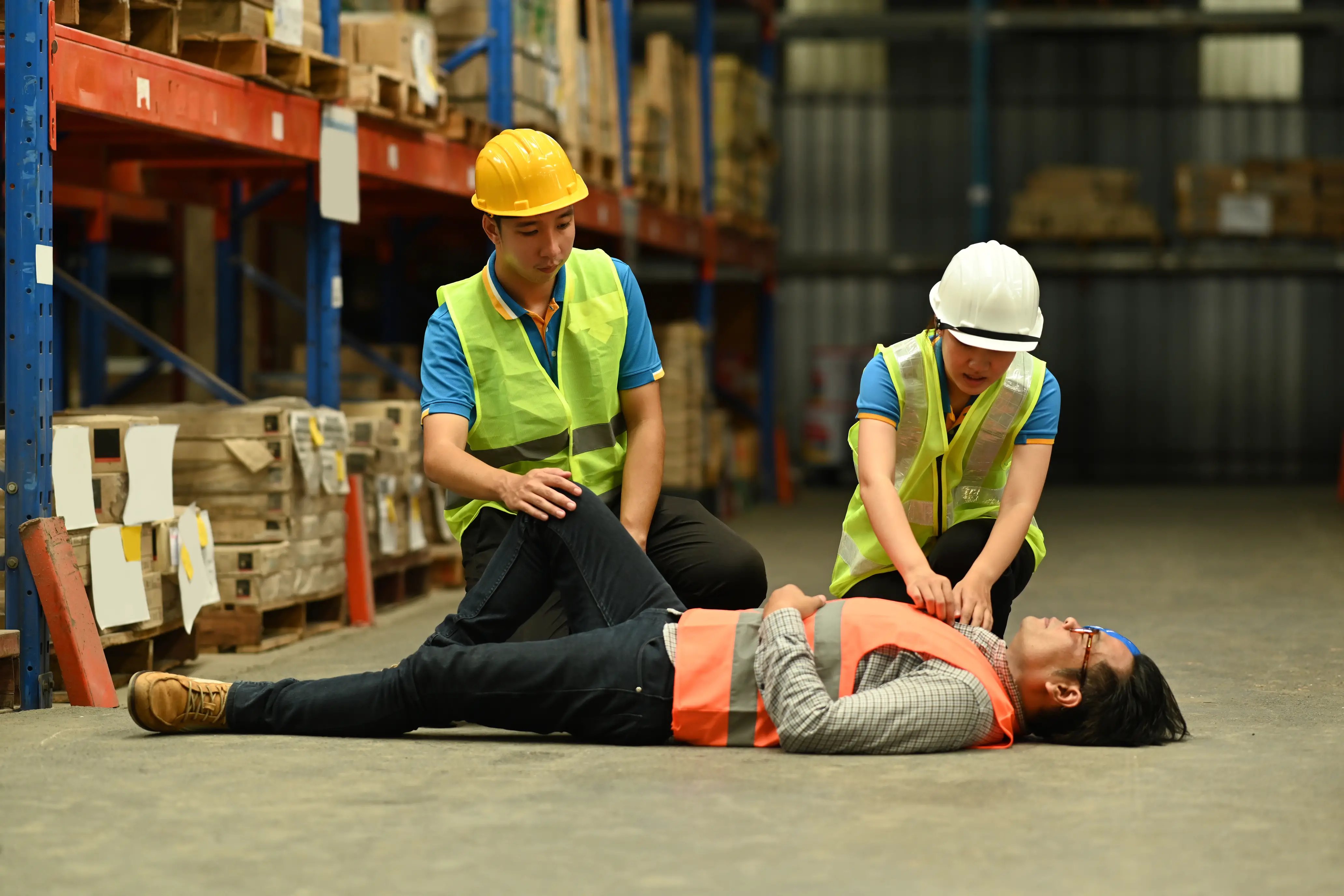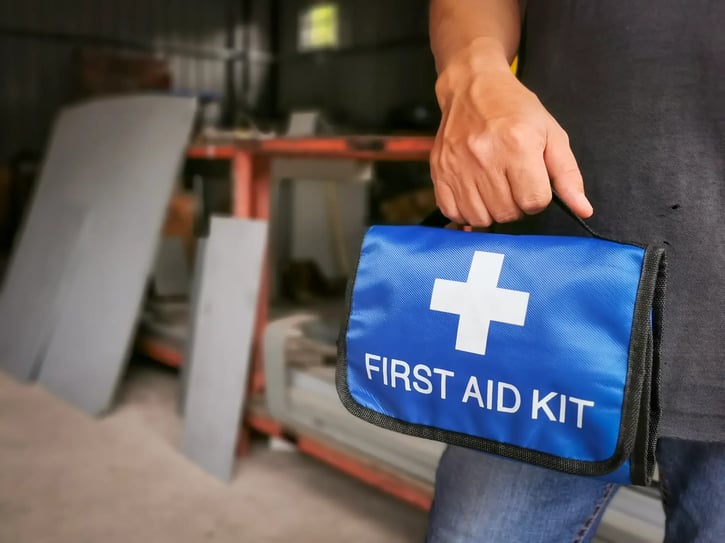In this guide, we'll explore the basics of first aid, legal requirements, and how you can ensure your workplace is prepared for any emergencies.
Understanding first aid in the workplace
First aid is the initial assistance given to a person suffering from an injury or illness. It's all about quick, basic help to prevent further injury, promote recovery, and preserve life until medical professionals can take over. In the workplace, first aid is not just about having a first aid kit; it's about being prepared and knowing how to respond in emergencies.
Key components of first aid
The key components of first aid include:
- CPR (Cardiopulmonary Resuscitation): Vital for cardiac arrest situations.
- Wound care: Managing cuts, scrapes, and other injuries to prevent infection.
- Fracture management: Handling broken bones and sprains.
- Handling medical emergencies: Like asthma attacks or allergic reactions.
- Basic first aid techniques: Covering a range of common medical conditions.
Legal requirements for first aid in the workplace
In the United States, the Occupational Safety and Health Administration (OSHA) sets the standard for workplace first aid. OSHA requires employers to provide proper first aid supplies, training, and equipment, based on the nature of the work and potential hazards.
Employer responsibilities for first aid provisions
As an employer, you're responsible for:
-
Ensuring adequate first aid supplies: Keeping a well-stocked first aid kit, with items like bandages, disposable gloves, and antiseptics.
-
Providing first aid training: Making sure employees receive basic first aid training.
-
Developing first aid procedures: Establishing clear steps for responding to medical emergencies.
-
Facilitating emergency services access: Having a plan for contacting and directing emergency services.
Consequences of non-compliance
Failing to meet these first aid requirements can lead to:
- Legal penalties: Non-compliance with OSHA standards can result in fines.
- Increased workplace injuries: Lack of first aid readiness can lead to more severe outcomes in accidents.
- Lower employee morale: Employees feel less safe if first aid measures are not in place.
Assessing your workplace first aid needs
When it comes to first aid in the workplace, one size doesn't fit all. Every workplace is different, and so are the first aid needs. Here's how to figure out what your workplace needs.
How to conduct a first aid risk assessment?
A first aid risk assessment is about looking closely at your workplace to see where and how injuries might happen. Think about the tasks people do every day, the tools they use, and the environment they work in. This helps you understand the kind of first aid you might need.
Factors to consider
When doing your assessment, consider:
- Size of the workforce: More people usually mean more chances of injuries.
- Nature of work: Some jobs are riskier than others. A construction site might have different first aid needs than an office.
- Workplace hazards: These can be things like machinery, chemicals, or even the layout of the place.
- History of work-related injuries: Look at past accidents to see what might happen again.
- Accessibility to medical care: How quickly can you get professional help if needed?
Tailoring first aid provisions to specific workplace needs
Once you know your risks, you can get the right first aid kit and equipment. You might need special items like face shields for CPR or bandages for burns, depending on your workplace. It's also crucial to train people in first aid specific to the risks they might face.
Setting up a first aid program
A good first aid program is more than just a box of bandages. It's a plan that helps you react quickly and correctly in an emergency.
Steps to develop a first aid program
Here's what you need to do:
-
Identify the requirements: Based on your risk assessment, figure out what kind of first aid you need.
-
Get the right equipment: This includes first aid kits with all the essentials, like bandages, disposable gloves, and maybe even things like latex gloves and disposable masks.
-
Choose your first aiders: Decide how many first aiders you need and pick the right people. They should be ready to step in when needed.
-
Provide training: Make sure your first aiders know what to do, whether it's treating minor injuries or knowing when to call emergency services.
-
Set up procedures: Everyone should know what to do in an emergency, from the person who gets hurt to the bystander who calls for help.
Choosing and training first aiders
Pick people who are calm under pressure and willing to help. They need training in basic first aid, CPR, and how to use personal protective equipment (PPE). Remember, the training should cover the most common medical conditions they might see in your workplace.
Procuring and maintaining first aid kits and equipment
Your first aid kits should always be stocked and up to date. Check them regularly for expired items like latex gloves and make sure they are easy to find and use.
Creating first aid procedures and emergency response plans
Write down clear steps for different emergencies. This might include how to treat an injured person, when to wear PPE, or how to contact emergency services. Regularly practice these procedures so everyone knows what to do.
Remember, a strong first aid program is an essential part of creating a safe environment. It's about being prepared, knowing what to do, and having the right tools at hand to help an injured individual. This not only helps in preserving life and preventing further injury but also shows your employees that their health and safety are a priority.
First aid training for employees

Ensuring that your employees are trained in first aid is a vital part of creating a safe workplace. Here's why it's important, what types of training are available, and how often training should be refreshed.
Importance of first aid training for all employees
First aid training is not just for a selected few. When more employees know basic first aid, the safer your workplace becomes. Here's why:
-
Quick response in emergencies: The faster someone gets help, the better their chances of recovery.
-
Confidence to act: Trained employees are more likely to step in and help during an emergency.
-
Preventing minor injuries from getting worse: Knowing basic first aid can stop small issues from turning into big problems.
-
Promoting a safe work environment: Training shows that health and safety are taken seriously.
Types of first aid training courses
There are different first aid courses available, depending on your workplace needs. Here are some common ones:
-
Basic first aid: Covers common injuries like cuts, burns, and fractures.
-
CPR and AED training: Teaches how to perform cardiopulmonary resuscitation and use automated external defibrillators, vital in cardiac arrest situations.
-
Specialized training: Depending on your workplace, you might need training for specific hazards like chemical burns or electrical injuries.
Recommended frequency of training refreshers
Skills can get rusty if not used. That's why it's important to refresh first aid training regularly. Here are some guidelines:
-
Basic first aid training: Refresh every two to three years.
-
CPR training: Because these skills are crucial and can fade quickly, a yearly refresher is recommended.
-
Specialized training: This depends on the risk level of your workplace. In high-risk areas, more frequent refreshers might be necessary.
Best practices in workplace first aid
Implementing best practices in workplace first aid is essential for ensuring a safe and prepared environment. These practices not only address immediate medical needs but also foster a culture of safety and care. Here are key aspects to focus on:
Regularly updating and practicing emergency response plans
Having a plan is great, but making sure it works is crucial. Here’s how to keep your plans effective:
-
Regular reviews: Update your emergency response plans regularly to reflect any changes in your workplace, like new equipment or changed layouts.
-
Mock drills: Conduct regular drills to practice these plans. This helps identify any gaps in the plan and familiarizes employees with emergency procedures.
-
Feedback and improvements: After drills, gather feedback from participants and use it to improve the plans.
Engaging employees in first aid awareness and training
Employee engagement is key to a successful first aid program. Here’s how to get everyone on board:
-
Accessible training: Offer first aid training sessions that are easy for all employees to attend. Consider different shifts and job roles.
-
Diverse learning methods: Use various training methods like workshops, online courses, and hands-on sessions to cater to different learning preferences.
-
Regular reminders: Send out regular communications about first aid tips and updates. This could be through emails, newsletters, or quick talks at meetings.
-
Encouraging volunteering: Motivate employees to volunteer for roles like first aiders or safety champions. This can help spread enthusiasm for safety and first aid.
By implementing these best practices, you not only comply with safety regulations but also create a workplace that values the health and well-being of every employee.

Employee scheduling and Time-tracking software!
Conclusion
Effective first aid in the workplace is crucial for ensuring a safe and responsive environment. By assessing first aid needs, setting up a comprehensive program, providing training, and integrating these practices into your overall safety culture, you create a workplace that not only meets legal standards but also cares for the well-being of its employees.
Remember, a well-prepared first aid plan is more than just a regulatory requirement; it's a fundamental aspect of a caring and responsible workplace. By prioritizing first aid, you're not just preparing for emergencies, you're also building a culture of safety, awareness, and mutual support among your team.




